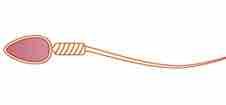![]()
![]()
![]()
Use LEFT and RIGHT arrow keys to navigate between flashcards;
Use UP and DOWN arrow keys to flip the card;
H to show hint;
A reads text to speech;
17 Cards in this Set
- Front
- Back
- 3rd side (hint)
|
What are the two types of organisms you need to know? |

Eukaryotes and Prokaryotes |
One has a nucleus, the other does not. |
|
|
Name three subcellular structures in plant cells which are not in animal cells. |
-Cell Wall -Permanent Vacuole -Chloroplasts |
1) supports the cell and makes it stronger 2) contains cell sap 3) where photosynthesis takes place |
|
|
What type of organism are Bacteria- prokaryotes or eukaryotes? |
Prokaryotes |
The DNA in a bacterial cell floats about in the cytoplasm- no nucleus |
|
|
How do you calculate magnification? |
Magnification = image size real size |
If image size = magnification x real size |
|
|
Which has a higher magnification - electron microscopes or light microscopes? |
Electron microscopes |
Which sounds cooler and more scientific? |
|
|
What does 'resolution' mean in terms of microscopy? |
Resolution is the ability to distinguish between two points. So basically how clear the microscope's image is. |
If you increase the resolution on an image does it become sharper or more blurry? |
|
|
What is 230000 in standard form? |
2.3 x 10 (to the power of) 5 |
wooo maths- Start with 2.3 and count how many times you'd have to multiply that by 10 before getting to 230000. Or just count the amount of numbers after the 2. |
|
|
Why would you add iodine to a sample on a microscope slide? |
to highlight the sample by adding colour - or just to make it easier to see. |
Iodine stains the sample |
|
|
What is differentiation? |
The process of a cell changing to become specialized. |
Think about the word - what does differentiate mean? To become different. So what is happening to the cell? |
|
|
How are sperm cells specialized for reproduction- give 2 ways: |
- Long tail and streamlined head so it can swim faster - lots of mitochondria as they provide the energy - enzymes in it's head to digest the egg cell membrane |

this is roughly what it looks like |
|
|
Why do xylem and phloem cells have little or no subcellular structures? |
So the stuff they are transporting can flow easily through. |
would it be more difficult to transport glucose and water through a cell with loads of stuff in the way? |
|
|
Why do muscle cells contain a ton of mitochondria? |
Because mitochondria provide energy, which the muscle cells need in order to contract. |
muscle cells do a lot of hard work- so what could they need in order to be able to do this? |
|
|
Where are chromosomes found within a cell? |
In the nucleus. |
most cells in your body have one of these |
|
|
How many pairs of Chromosomes are in a human cell? |
23 pairs. 46 individual ones. |
they get two copies of each Chromosome, one from the mother, one from the father. 46 in total. |
|
|
What is the first stage of the cell cycle? |
The cell has to grow and increase the amount of subcellular structures, like mitochondria and ribosomes. |
increasing something... |
|
|
What do you call the new cells that the original cell creates? |
The daughter cells. |
Not the mother cells... or the son cells... but the..... |
|
|
What are undifferentiated cells called? |
Stem cells. |
Cells which are unspecialised. |

